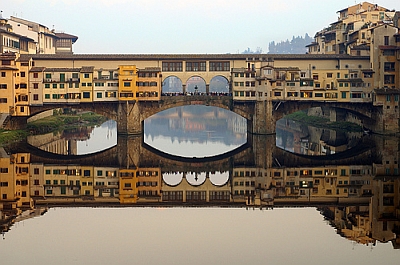Gay Ponte Vecchio and the Office of the Night April 21, 2015
Author: Beach Combing | in : Medieval , trackbackFlorence was famous in the renaissance for its relative tolerance for homosexuality. True, after one sermon by Bernardino of Siena bonfires were prepared for any ‘sodomites’ and Savonarola and his allies were also violently disposed towards homosexual citizens. However, homosexuals were not, outside of Christian rhetoric, routinely burnt and in many cases ‘the Office of the Night’ (Florence’s sex police) closed an eye to homosexual activities in the city. Indeed, so liberal was Florence in renaissance terms, so prevalent was homosexuality that sodomy was referred to as ‘the Florentine vice’ in much of the rest of Italy. Beach knew all of this, as, of course do many of his readers, but he has recently been reading about the homosexual underground in the city of Flowers and discovered the unlikely homosexual heart of fifteenth-century Florence: the beautiful Ponte Vecchio…
For those who don’t know it Ponte Vecchio is a stylish medieval landmark with gold and jewelry shops running across it: the only one of the four medieval bridges on the upper Arno to escape German bombs in the summer of 1944 it is one of the oldest river-crossers in the world. It has appeared on this blog on three previous occasions: once for the Vasari Corridor and once as a love goddess and once in connection with a now lost statue of the god Mars. The bridge has in short bizarre form… In the 1400s it was part of a lower class neighbourhood with artisan workshops and crucially for the homosexual geography of Florence it was near Il Buco (literally ‘the Hole’*) Florence’s gay bar, where men in coloured tights and silly hats sang YMCA into the early hours. From 1478 to 1502 fifty homosexual crimes recorded by the Florentine police involved individuals who worked on the bridge, an incredible number for perhaps a dozen shops and workshops.
Michael Rocke who gathers the evidence together in his fascinating Forbidden Friendships: Homosexuality and Male Friendship in Renaissance Florence evokes a febrile atmosphere where men swapped younger lovers and employed the commercial premises on the bridge as their trysting places. So next time you are walking over Ponte Vecchio having looked at the love locks and opened your wallet to get bilked for some mediocre gelato remember when Ponte Vecchio was a sexual playground for Florence gay population. How things change…
Other famous but disconcerting gay haunts from ancient or medieval history: drbeachcombing AT yahoo DOT com The early modern ones are, in most cases, too well known to be worth recording?
*Buco is still ‘fag’ (or some such offensive word) in Tuscan



